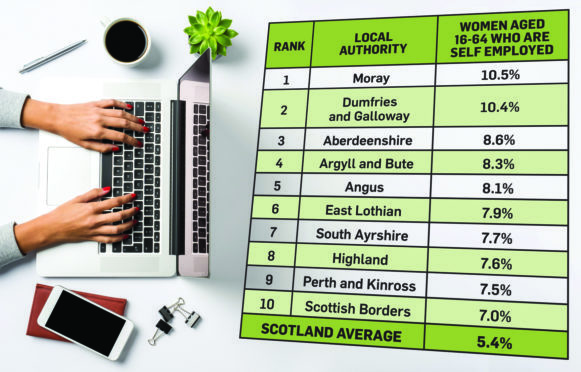Moray is a hotspot for female entrepreneurs, according to new research from the Federation of Small Businesses (FSB).
Figures show the region has a higher share of women who work for themselves than any other mainland Scottish local authority area.
There are 9,700 women in Edinburgh who work for themselves, more than any other local authority.
But more than one in 10 (10.5%) working age females in Moray are self-employed, a larger share than any other mainland council.
Aberdeenshire has the third highest number of women, 7,000, who work for themselves in the country, around 8.6%, while Aberdeen City was eighth in the country with 4,100.
In the Highlands 7.6% of working women are self-employed ranking the region 8th highest in Scotland.
The research was compiled ahead of an address from First Minister Nicola Sturgeon to a gathering of Scottish small business owners where she said: “These figures illustrate that self-employed women are making a huge contribution to local economies and communities.
“But I also know that being your own boss isn’t easy. That’s why I’m looking forward to speaking to FSB’s annual dinner – to underline smaller firms’ contribution to the Scottish economy and to set out the ways the Scottish Government is giving local firms the best chance of success.”
Official figures show there are 94,900 self-employed women in Scotland, 5.4% of the working age population. But Scottish men are much more likely to be their own boss with 183,300 self-employed – equivalent to 11% of the working age population.
Research by Women’s Enterprise Scotland shows that women-led businesses contribute more than £5 billion towards the Scottish economy. However if this matched those led by men, this figure would increase to £13bn.
Pearl Hamilton, Forres-based business owner and member of FSB’s Scotland policy unit said: “It is great to see my part of the country top the women in business table. Female entrepreneurship is far higher in rural Scotland than in our cities. That’s not only because people move out to the country to start-up, but also large private and public employers are few and far between in many rural areas.
“For every woman in business for herself in Scotland, there are two men. That’s not good enough in 2018. At FSB, we’ve made the case to governments north and south of the border for extra support for female business owners. We’ve argued for extra maternity help for self-employed women and more enterprise education in schools.
“But we also need to celebrate the contribution of women who work for themselves – no matter the scale of their operations.”
